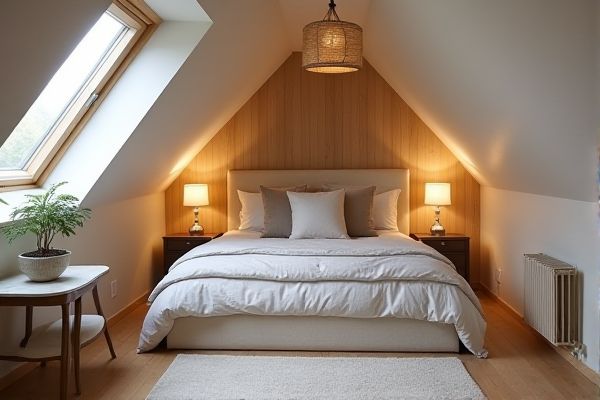
A built-in attic bed maximizes space by integrating sleeping quarters into attic nooks, offering a cozy and permanent solution, while a Murphy bed folds neatly into a wall, providing versatile, space-saving benefits ideal for multipurpose rooms. Discover how each option can transform Your living area by reading the rest of the article.
Table of Comparison
| Feature | Built-in Attic Bed | Murphy Bed |
|---|---|---|
| Space Efficiency | Utilizes attic space, ideal for sloped ceilings | Folds vertically against wall, frees floor space |
| Installation | Requires custom carpentry, permanent structure | Easier installation, wall-mounted mechanism |
| Cost | Higher cost due to customization and structure | Generally more affordable, mass-produced options |
| Flexibility | Fixed location, limited room rearrangement | Can be folded away, flexible for multi-use rooms |
| Design | Integrated with room architecture, custom style | Modern or traditional styles, visible when folded |
| Comfort | Full mattress size, stable sleeping surface | Depends on mattress type, potential space constraints |
| Maintenance | Minimal, built-in and durable | Requires mechanism upkeep, possible repairs |
Introduction to Space-Saving Beds
Built-in attic beds maximize vertical space by integrating sleeping areas into lofted or sloped ceiling rooms, making them ideal for compact attic conversions. Murphy beds fold up against the wall, freeing floor space during the day and providing versatile functionality in small apartments or guest rooms. Your choice between these space-saving beds depends on room layout, ceiling height, and how you plan to optimize living areas efficiently.
What Is a Built-In Attic Bed?
A built-in attic bed is a custom-designed sleeping area integrated directly into the sloped ceiling or wall space of an attic, maximizing the compact area for efficient use. This type of bed often features storage compartments and tailored dimensions to fit unconventional attic shapes, offering a cozy and space-saving solution for small rooms. You can enhance your attic's functionality while maintaining a seamless aesthetic with a built-in attic bed.
What Is a Murphy Bed?
A Murphy bed, also known as a wall bed, is a space-saving sleeping solution that folds vertically into a cabinet or wall, maximizing floor space in small rooms or apartments. Unlike a built-in attic bed, which is typically fixed in a loft or attic area, a Murphy bed offers flexibility by transforming your living area into a multifunctional space without permanent installation constraints. Your choice depends on the room layout and how much versatility you need for daily living versus a dedicated sleeping nook.
Design and Aesthetic Considerations
Built-in attic beds seamlessly integrate with existing attic architecture, maximizing space while providing a custom, cozy aesthetic that often features wood paneling or sloped ceilings for a rustic charm. Murphy beds offer sleek, modern designs that fold neatly into walls or cabinets, creating a minimalist look ideal for small urban apartments or multifunctional rooms. Both options enhance room functionality but differ in visual impact; built-in attic beds emphasize warmth and structural integration, whereas Murphy beds highlight clean lines and contemporary style.
Installation Requirements and Complexity
Built-in attic beds require custom carpentry and structural adjustments to fit the sloped ceilings and unique dimensions of attic spaces, often involving reinforcement and precise measurements. Murphy beds, designed for wall mounting, typically need a sturdy vertical wall and can be installed with modular hardware kits, making the process more standardized but still requiring careful alignment to ensure smooth operation. When considering installation complexity, your attic bed demands professional craftsmanship tailored to your space, while a Murphy bed offers a semi-DIY option if your wall structure supports it.
Space Efficiency Comparison
A built-in attic bed maximizes space by utilizing often-underused attic areas, seamlessly integrating storage solutions and freeing up floor space for other activities. Murphy beds offer versatile space efficiency by folding vertically against the wall, transforming bedrooms or living rooms into multi-functional spaces without permanent construction. Your choice depends on whether you prioritize a custom, permanent setup (attic bed) or a flexible, retractable option (Murphy bed) to optimize your home's square footage.
Comfort and Mattress Options
Built-in attic beds often allow for customized mattress sizes, providing flexibility to maximize comfort tailored to unique attic dimensions, while Murphy beds typically accommodate standard mattress sizes like twin or queen, which can limit personalization. The fixed frame of built-in attic beds supports thicker, high-quality mattresses, enhancing long-term comfort, whereas Murphy beds require thinner mattresses designed to fold vertically, potentially compromising cushioning. Both options offer space-saving benefits, yet built-in attic beds prioritize comfort through adaptable mattress choices, contrasting with Murphy beds' emphasis on functionality and ease of storage.
Storage Capabilities and Customization
Built-in attic beds offer extensive storage capabilities with integrated wardrobes, drawers, and shelving tailored to the unique angles and limited space of attic rooms. Murphy beds provide versatile customization options, allowing wall-mounted designs that fold up to free floor space, often incorporating hidden cabinets or shelving units to maximize storage. Both solutions enhance space efficiency, but built-in attic beds excel in permanent, bespoke storage solutions while Murphy beds prioritize flexible use of multifunctional rooms.
Cost Analysis: Built-In Attic Bed vs Murphy Bed
Built-in attic beds typically involve higher upfront construction costs due to custom carpentry, structural modifications, and specialized materials tailored to attic dimensions. Murphy beds offer a more budget-friendly alternative with lower installation expenses and readily available standard designs that require minimal alteration to existing spaces. Maintenance and long-term durability costs for built-in attic beds may rise, while Murphy beds provide cost-effective replacements or repairs, enhancing overall affordability.
Choosing the Best Option for Your Space
Built-in attic beds maximize vertical space by integrating sleeping areas into sloped ceilings, ideal for compact rooms with limited floor space. Murphy beds offer flexibility by folding into the wall, freeing up floor area for daily activities and making them perfect for multifunctional spaces. Evaluate your room's dimensions, storage needs, and daily usage to determine whether a built-in attic bed or a Murphy bed best suits your space and lifestyle.
 homyna.com
homyna.com